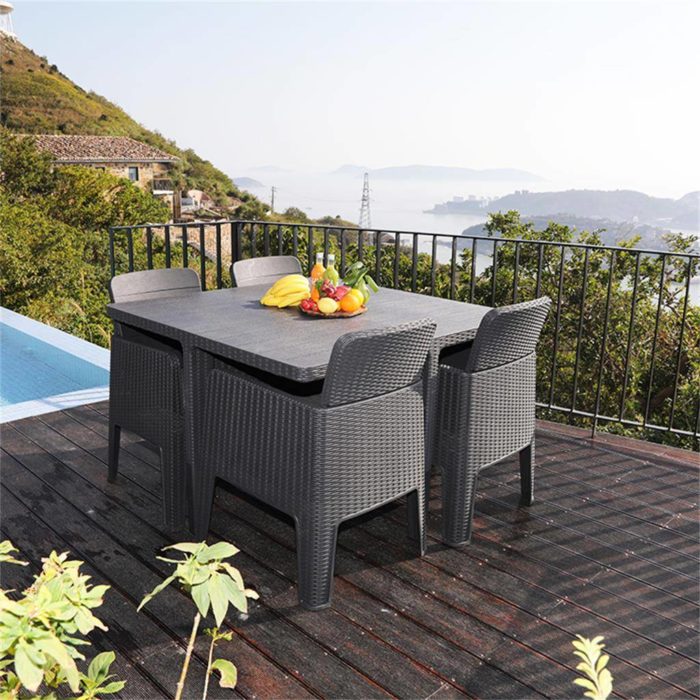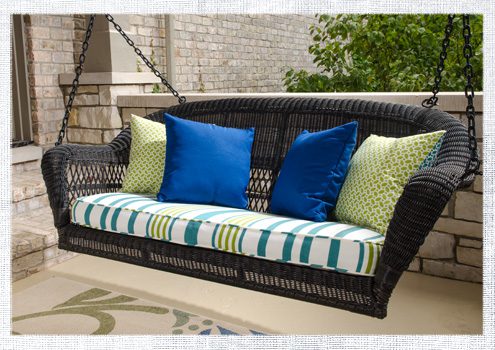Conclusion
Before you start reading, here is the conclusion.
Plastic chairs, if exposed to the sun for an extended period of time, will fade.
One of the most common indications that a plastic chair has been damaged by the sun is cracks on its surface.
Other symptoms may not be as apparent initially, but once detected, it’s important to take action before the damage spreads.
Another indication of UV radiation damage on plastic is the fading of color.
If you start to see UV radiation can fade and discolor plastic chairs over time. Here are a few ways to prevent this from happening:
- Choose high-quality furniture that is UV resistant
- Use UV protection on the furniture
- Clean furniture regularly to remove dust and grime
- Place furniture in an area with less sun exposure or add shades, awnings, or other forms of protection.
Introduction
When it comes to purchasing outdoor furniture, there are a few things to bear in mind. Buying outdoor furniture isn’t as simple as buying other types of Furniture.
There is a lot more thought and care put into this process, especially because the furnishings are subjected to the elements just like the UV rays of the sun.
It’s essential to purchase furniture that will withstand the weather and is also stylish and comfortable.
Before you spend money on outside plastic chairs for your patio or outdoor gathering area, be sure to understand how to pick the right outdoor furniture material and how to preserve it looking new for longer.
What causes UV Radiation
UV radiation is the main cause of plastic chair fading.
It’s important to be able to identify the different types of UV radiation in order to take the necessary precautions.
There are three types of UV radiation: UVA, UVB, and UVC.
UVA radiation is the most common and is known to cause skin cancer.
It can also cause fading and discoloration on plastic chairs.
UVB radiation is the second most common and is known to cause sunburns.
UVC radiation is the least common and is known to be the most harmful. It can cause skin cancer and cataracts.
When it comes to protecting your outdoor furniture from sun damage, using a product with a high SPF is the best way to go.
Sun protection lotions for furniture are available in a variety of SPF levels. The higher the SPF level, the more protected your furniture will be from the sun’s rays.
Look for a product that has an SPF level of 30 or higher.
Products that contain zinc oxide are ideal for protecting furniture from the sun. Zinc oxide is a natural mineral that reflects and blocks UVA and UVB radiation.
It’s also non-toxic, which makes it a safe choice for furniture.
The Effects of UV on Plastic
For many years, plastic has been perceived as a low-quality, low-cost material, especially when it comes to furniture. It is extremely vulnerable to the sun’s UV radiation.
Ultraviolet radiation can damage over time and may cause serious side effects on the human body’s skin, even if exposed to moderate amounts of radiation.

The sun’s UV radiation is divided into three distinct electromagnetic spectra: UVA, UVB, and UVC.
The sun’s rays have such a small wavelength that they are imperceptible to the naked lens.
A nanometer is a unit of measurement used to measure this.
With UVC as the bottom end, UVA has the highest
When UV radiation comes into contact with the plastic chair’s surface, it can induce a range of indicators of damage.
The most prevalent symptoms are a brittle surface, a color change, and a gritty look.
Another important reason to protect your plastic chair from UV rays it can activate photons that create free radicals.
This might harm the chair over time since it causes material deterioration and lowers the chair’s safety.
This is something to think about if you invest in outdoor plastic chairs.
You want to make sure that your customers are safe and protected by selecting an outdoor plastic chair that is resistant to UV damage so it won’t deteriorate quickly.
How to Check for Signs of UV Damage on a Plastic Chair?
The easiest way to prevent UV damage on a plastic chair is to avoid it.
However, before you learn more about UV resistance in plastics, it’s vital to determine whether your plastic chair has been damaged.
Early detection is critical for preventing damage from spreading and preserving the materials’ integrity.
 The presence of cracks on the plastic chair’s surface is one of the surest indicators of damage. Some of these symptoms might not be apparent at once. Once you detect the fractures and other signs of harm, you can be certain that the extent of the damage has already grown considerably.
The presence of cracks on the plastic chair’s surface is one of the surest indicators of damage. Some of these symptoms might not be apparent at once. Once you detect the fractures and other signs of harm, you can be certain that the extent of the damage has already grown considerably.
The discolouration is another typical indication of UV damage on a plastic chair.
Plastic fades with time, and it is one of the most prevalent consequences of UV radiation. When the color starts to fade or has a tinge to it, it is indicating UV damage.
Other Methods for Preventing Plastic Chairs Fading
Choosing the finest sort of material for UV resistance is a good idea. It adds value to your money because the furniture and plastic chairs will last a long time since they are resistant to fading. It’s also critical that you take basic precautions to protect the furnishings.
This will allow you to use it for a longer period of time, even if exposed to the sun.
1. Use UV Protection.
With UV protection, one of the most effective methods to prevent plastic chair fading is available.
There are a number of these products on the market that are meant to protect surfaces from damage caused by UV light exposure. Excessive sun exposure can cause fading.
These lotions function as sunscreen for outdoor furniture by blocking UV rays and preventing them from reaching the surface
2. Regularly clean your furnishings.
The greatest way to keep outdoor furniture from fading or showing signs of wear is to maintain it on a regular basis.
Dust or grime that has gathered on the surface should be removed.
Just as harmful as the sun’s UV rays, these can do plenty of damage. Wiping it clean with a clean cloth is one option; pressure washing your outdoor furniture is another.
3. Keep it shaded.
It doesn’t matter how lovely or useful your outside space is intended to be.
It doesn’t imply that you have to expose it directly to the sun, even if it’s in an area where the sun comes out all day.
Adding awnings, shades, or other protection to your outdoor space will safeguard your furniture from the sun’s rays and preserve it from fading.
You can also reduce the rate at which your plastic chairs fade by reducing the amount of sunlight in your outside area.
You can also buy protective covers for your furniture.
These covers are made of a UV-resistant material and will help to keep your furniture from fading.
When choosing a cover, be sure to select one that is the appropriate size for your furniture. Covers that are too small will not provide adequate protection, while covers that are too large will be difficult to use.
4. Use it more
The more time you spend lounging outdoors using your outdoor furniture, the more able you are to help it avoid sun damage and fading.
If you spent a lot of money on high-quality outdoor furniture, it’s only natural for you to use them as often as possible.
5. Choose high-quality outdoor furniture.
This is the greatest solution for maintaining your plastic furniture looking new when utilized on the patio.
When it comes to outdoor seats, cutting corners isn’t a good idea since it may end up costing you more money in the long run.
If you choose a less expensive, lower-quality chair, you may save money.
However, within only a few months of use, you will notice that it fades. If you have to replace your furnishings frequently because they are made of plastic or other cheap materials, your savings will be worthless.
Be assured that what you get from Yoho isn’t something you’ll have to hire a maintenance crew for every three months.







